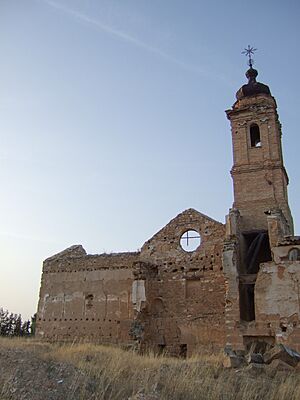Trapa de Santa Susana facts for kids
The Monastery of Santa María de la Trapa de Santa Susana, often called Trapa de Santa Susana or just La Trapa by people nearby, is a very old, ruined building. It's a monastery, which is a place where monks live and pray. You can find it near the town of Maella in Aragon, Spain, close to a road called A-1411.
This monastery is located in the area of Maella. In the past, this specific spot was known as Priorat de Santa Susanna de Maella. Over its long history, the monastery had good times and bad times. Now, it stands mostly in ruins.
Contents
History of the Monastery
Early Days and Changes
The first monastery here was built a very long time ago, in the 6th century. That's over 1,400 years ago! It was started by Benedictine monks, who are a type of Christian religious group. At some point in its first 600 years, these monks rebuilt it with help from another group called the Order of Calatrava.
Later, in 1227, a king named James I of Aragon gave the monastery to a different group of monks, the Cistercian Order. These Cistercian monks then took down the old building to construct a brand new monastery in its place.
In the 1500s, a local lord named Miguel Pérez d'Almazán tried to start a new village near the monastery. He wanted to call it Villanueva d'Almazán, but his plan didn't work out.
The Trappist Monks Arrive
During the time of the French Revolution (a big change in France around the late 1700s), some French monks from a group called the Trappists came to this monastery. They were welcomed here, and soon a strong Trappist community grew. This is why the place became known as Trapa de Santa Susana.
Even though there was a war called the Peninsular War (early 1800s) that caused a lot of damage, the community of monks kept growing.
The End of Monastic Life
However, in the mid-1800s, a big change happened in Spain. It was called the Ecclesiastical Confiscations of Mendizábal, or La Desamortización. This was when the Spanish government took control of many church properties, including monasteries. Because of this, the monks had to leave, and monastic life at Trapa de Santa Susana came to an end.
Why the Name Santa Susana?
Local stories say that the monastery got its name because, at some point in its history, it held the remains of Saint Susanna. People in the area sometimes called her "Virgen de Levante," which means 'Levantine Virgin'.
Today, the ruins stand alone on one side of the road. The graceful bell tower is easy to spot in the quiet landscape, even though there are some farm buildings nearby.
See also
 In Spanish: Monasterio de Santa María de la Trapa de Santa Susana para niños
In Spanish: Monasterio de Santa María de la Trapa de Santa Susana para niños


